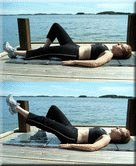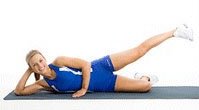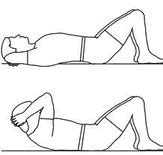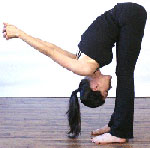

Golf
Exercises to Keep You on the Golf Course
In the game of Life, people are continually looking for something to bring happiness to their day. Happiness is defined differently by every person globally; some enjoy music, books, movies, sports, etc. Many people love to play sports and play as often and for as long as possible. To do this, these people must take proactive measures to prevent injury.
The steps to prevent an injury are relatively basic but require good discipline. The athlete needs to start with a healthy diet to have enough energy. Second, depending on the sport, the athlete might need to build muscle through exercise to compete. Finally, every athlete should stretch before playing their sport to warm the muscles.
Golf is a physically challenging game. Reading the last sentence might cause you to react with a "What? Golf?". It is an understandable reaction. Most professionals have someone carry their clubs for them, so to the outside observer, it appears as though they are only hitting a ball that does not move and walking.
Regular players find it more challenging to carry their clubs for the round. Assuming they are not using a cart to drive them around, the regular golfer has to walk roughly 3 miles per 18 holes carrying a 25-30-pound bag on their shoulder and swinging their body regularly. The golf swing itself can tax the human body, as many different parts must work together to create enough torque for the swing to happen.
Now that I have convinced you that golf can be taxing, you might wonder how to prepare for playing. The answer, of course, is exercise! You can exercise for strength and flexibility, and what is referred to as "core" exercises are critical for playing the sport. You might think you can get away with not doing any of these, but doing them will give you better odds of playing the sport for a long time.
So, what exercises should you start with first?
There is no exact, recommended order for this, but strengthening your body's core (i.e., your abdomen, back, quadriceps, and shoulders) is a good starting place. Once your core is strengthened, you can focus on your body's other muscles for optimal conditioning.
Figure 1 -Plank |
Some of the core exercises might surprise you with their difficulty. One example of this is the plank exercise (see Figure 1). This exercise is easy, but once you have tried it, especially if you are not in good shape, you will find it is pretty tough. |
Another good core exercise is the supine leg lift (see Figure 2). To perform this exercise, lie flat on the floor, lift one leg, and hold it for 1-2 seconds. Do this approximately 10-15 times, and then switch legs. Alternatively, you can perform the lateral leg lift exercise (see Figure 3); both exercises build strength in your abdomen and legs.
Figure 2 - Supine leg lift |
Figure 3 - Lateral leg lift |
Everyone wants the "washboard abs" that will look good at the beach. Did you know that the abdominal muscles are vital for your golf swing? The abdominals provide a lot of the torque necessary to drive the ball. The crunch is one of the best abdominal exercises (see Figure 4). You lie flat on the ground and sit up to lift your shoulders off the ground, using your abdominal muscles to do so. |
Figure 4 - Crunch |
Figure 5 - Bending Stretch |
It is vital to incorporate strength and flexibility exercises into your routine. Strength exercises like the bench press can help you develop the power to hit the ball further. Flexibility exercises such as the bending stretch (see Figure 5) are key to your workout and stretching routine. This stretch is also central to warming up for a round of golf. |
If golf makes you happy, why not prepare your body to enjoy a lifetime of it as long as physically possible? If you play golf frequently without taking care of your body, overuse of muscles or lack of strength can occur. Would you prefer to play golf until you are in your 70s-80s or stop playing in your 40s-50s due to poor health? Your 70s-80s, of course!
Why warm-up?
The most common reasons given for warming up included:
- To play better (74.5%)
- To prevent injury (27%)
- Because everyone else does (13.2%)
Common reasons for not warming up were:
- Do not need to (38.7%)
- Do not have enough time (36.4%)
- Cannot be bothered (33.7%)
Does it matter? It does for injury prevention since golf is a popular sport with no age limits. The tendency for the players to be older and often not in good physical condition contributes to injury risk. Ironically, but perhaps predictably, the more senior golfers in this study were least likely to warm up.
According to emergency departments and sports medicine clinics, the researchers point out that golfers commonly suffer sprains and other overuse injuries, as well as acute traumatic injuries, falls, and impacts with golf balls. Pro-golfers have a higher injury rate (lifetime injury risk of 89% compared with 57-62% for amateurs. Still, beginners tend to have less well-conditioned bodies and stress their musculoskeletal systems more during the golf swing.
An appropriate warm-up for golfers would include aerobic exercise to raise body temperature, followed by stretching the "golf muscles and joints" (hands, wrists, forearms, shoulders, lower back, chest, trunk, hamstrings, and groin) and, finally, a series of golf swings with progressive increases in range of movement and vigour.
In this study, golfers who claimed to know what sort of warm-up reduced injury risk were more likely to warm up than those who did not. The researchers conclude: "Knowledge of the injury prevention benefits of warming up appears to be a significant motivator of positive attitudes and behaviours."
Page Reference
If you quote information from this page in your work, then the reference for this page is:
- CHERWONIAK, H. (2009) Exercises to Keep you on the Golf Course [WWW] Available from: https://www.brianmac.co.uk/articles/article054.htm [Accessed
About the Author
Herb Cherwoniak has a B.Sc. in Kinesiology and is an avid golfer.




